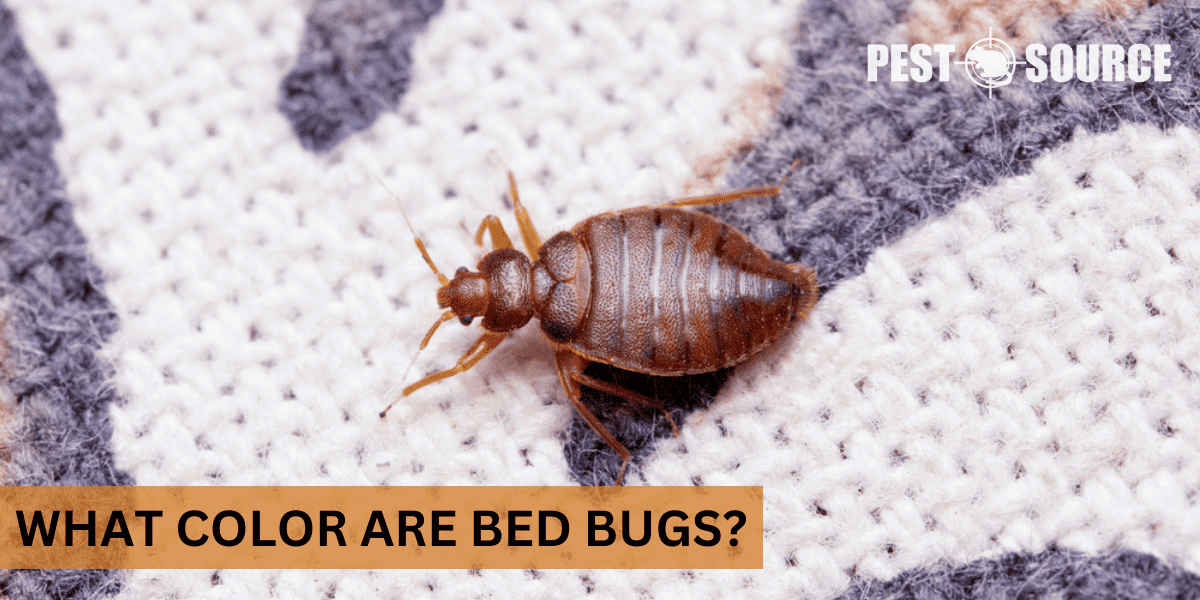Bed bugs are typically reddish-brown in color, though their bodies may become redder after feeding due to the blood they’ve ingested. Nymphs, or younger bed bugs, can appear more translucent or lighter in color before they feed. The article that follows will expand on the color variations of bed bugs throughout their life cycle and after feeding events.
POINTS
- Bed bugs exhibit different color variations, which are primarily determined by their life stage and feeding status, ranging from nearly translucent for nymphs to light or dark brown for adults.
- The color of bed bugs can change significantly after feeding, turning from brown to a darker, reddish-brown hue due to the blood visible through their translucent exoskeleton.
- Identifying the color of bed bugs is essential for early detection and treatment of infestations, as well as distinguishing them from similar-looking household pests.
- Color alone cannot be relied upon to identify bed bugs, as other factors such as size, shape, and behavior are also crucial for accurate identification.
- If you suspect a bed bug infestation, confirm the identification of the insect, inspect for signs of infestation, and consult a professional pest control provider to recommend appropriate treatment measures.
What Are the Basics of Bed Bug Color?
What color are bed bugs?
Bed bugs are typically brownish in color, ranging from light to dark brown. However, their color may change depending on their age, feeding status, and other factors. Being able to identify the color of bed bugs is essential in determining if you have an infestation and for proper pest control.
Why is identifying the color of bed bugs important?
Correctly identifying the color of bed bugs is crucial for several reasons. First, it can help you to identify an infestation early, allowing you to take action before it becomes a significant problem. Second, it can help you to differentiate between bed bugs and other insects that may resemble them in shape and size. Finally, understanding the different color variations of bed bugs can provide insight into their life cycle stages, making it easier to target specific pest control methods.
What variations exist in the color of bed bugs?
There are a few variations in bed bug color, primarily based on their life stage and feeding status. These include changes from nearly translucent to dark brown. Subtle differences may also be observed between adult male and female bed bugs.
The Life Cycle of Bed Bugs and Their Corresponding Colors
What color are bed bug eggs?
Bed bug eggs are tiny, measuring around 1mm in length, and are generally pearly white or cream-colored. They can be difficult to spot on light-colored surfaces, and their translucent nature makes them even more challenging to see.
What color are nymphs, or young bed bugs (1st-5th instar)?

Nymphs, or young bed bugs, start out as nearly translucent, making them difficult to see against light-colored surfaces. As they progress through their five developmental stages, nymphs will gradually darken in color. By the time they reach the fifth instar, they will typically be light brown.

Do the colors of adult male and female bed bugs differ?
While adult male and female bed bugs are generally very similar in color, there may be slight variations. Males tend to be somewhat darker in color than females, though these differences are often difficult to discern without close examination.
What color are adult female and male bed bugs?
Adult female and male bed bugs are usually brown, with hues ranging from light to dark brown. Some may have a more reddish tint, especially after feeding.
Why and how does the color of bed bugs change throughout their life cycle?
The color of bed bugs changes throughout their life cycle due to their growth and development. As they progress through various stages (from egg to nymph to adult), their exoskeleton hardens and becomes darker. Additionally, their color may also change based on their feeding status, with bed bugs appearing darker and more reddish-brown after feeding on blood.
Color Differences Based on Feeding Status: What Happens When Bed Bugs Feed?
How does the color of bed bugs change after feeding?
The color of bed bugs can change significantly after feeding. When they consume a blood meal, their abdomens engorge, and their overall color can shift from brown to a darker, reddish-brown hue. This is due to the blood visible through their translucent exoskeleton.

Why do bed bugs appear brown?
Bed bugs appear brown because of the pigmentation in their exoskeleton, which is made primarily of a substance called chitin. This pigmentation plays a crucial role in providing them with camouflage in their natural environment, such as on mattresses, sofas, and other household items where they commonly reside.

Why are fed bed bugs reddish-brown?
Fed bed bugs become reddish-brown due to the blood they consume during a meal. As their abdomens fill with blood, the blood becomes visible through their translucent exoskeleton, causing their overall color to appear darker and more reddish.
Can bed bugs appear yellow, and if so, why?
Bed bugs are not typically yellow, but their eggs may show a slightly yellowish hue, especially when they are recently laid. However, this is more accurately described as a pale cream or off-white color.
Are there any other color changes related to feeding?
Besides the more noticeable color difference after feeding, no other significant color changes are associated with bed bug feeding habits.
Bed Bug Variations: Are There Light, Tan, or Orange Bed Bugs?
Are there light brown or tan bed bugs?
Some bed bugs may appear light brown or tan, particularly when they are nymphs or have recently molted. However, they will generally darken as they grow and molt through their life cycle stages.
What about orange bed bugs, do they exist?
Orange bed bugs do not typically exist. The variation in bed bug color is generally limited to shades of brown and some reddish hues after feeding.
Can there be translucent or light-colored bed bugs?
Translucent or light-colored bed bugs can occur, especially in the early stages of their life cycle as nymphs. When they first hatch, nymphs are nearly translucent, making them difficult to see without a magnifying glass or bright light.
Are there dark brown bed bugs?
Dark brown bed bugs are quite common, mostly found in adult bed bugs and particularly in males. They may appear almost black in some instances, depending on factors such as lighting and the surface they are on.
What factors could contribute to these unusual color variations?
Factors such as genetics, environmental conditions, and diet can influence the color of bed bugs. For example, if a bed bug population is isolated and has a limited gene pool, unusual color variations may occur, though this is relatively rare. Environmental factors such as temperature, humidity, and exposure to light may also contribute to color variations.
Bed Bug Size and Appearance: How Does Color Influence This?
How does the color of bed bugs contribute to their overall appearance?
The color of bed bugs plays an essential role in their overall appearance as it helps provide them with camouflage in their environment. Additionally, it offers valuable information about their life cycle stage, feeding status, and overall health. Recognizing bed bugs’ colors is a crucial step in identifying and treating infestations effectively.
What are the sizes of bed bugs, and how does this relate to their color?
Bed bugs vary in size based on their life stage:
- Eggs are tiny (about 1mm) and have a pearly white or cream color.
- Nymphs start out nearly translucent and grow to approximately 2.5mm (1st instar) to 4.5mm (5th instar) in size. As they grow, their color gradually becomes darker.
- Adult bed bugs measure approximately 5-7mm in length and are brown, ranging from light to dark brown.
Knowing the size and color of bed bugs at each life stage can help you identify individual bugs within an infestation and target appropriate pest control measures.
Can the size of bed bugs influence their perceived color?
The size of bed bugs can influence their perceived color in some cases. Smaller nymphs may be more challenging to see, especially when they are nearly translucent early in their life cycle. As they grow and darken, their size and color become more apparent, making it easier to detect them.
Identifying Bed Bugs by Color: How Reliable Is It?
How reliable is color as an indicator of a bed bug infestation?
Although color is an important factor in identifying bed bugs, it should not be solely relied upon for determining the presence of an infestation. Various other insects may share similar coloration, which could lead to misidentification. Monitoring other signs, such as the presence of eggs, fecal spots, skin sheddings, or actual bites, is also essential to confirm an infestation.
Are there other bugs that might be mistaken for bed bugs based on color?
Yes, other insects may share similar coloration with bed bugs, potentially leading to misidentification. Examples include bat bugs, carpet beetles, and some species of spider beetles. Additionally, cockroach nymphs and immature stages of fleas may also resemble bed bugs to some extent.
How can you differentiate between bed bugs and other similarly colored bugs?
To differentiate between bed bugs and similarly colored bugs, it is crucial to consider the insect’s overall appearance, size, shape, and behavioral patterns. Bed bugs have a distinctive flat, oval-shaped body and a characteristic “musty-sweet” odor. Consult with a pest control professional if you are unsure about the identification of a suspected bed bug.
Are light-colored bed bugs more common in certain environments?
Light-colored bed bugs may be slightly more common in environments with lighter-colored fabrics, furniture, and other surrounding surfaces. However, bed bug color is primarily determined by their life cycle stage and feeding status, not their environment.
Can the environment influence the color of a bed bug?
While the environment does not directly influence a bed bug’s color, it may play a role in how easily you can detect them. Lighter-colored surfaces may make light-colored bed bugs more visible, and vice versa. Environmental factors such as temperature, humidity, and exposure to light could also contribute to subtle color variations, though genetics and life stage are the primary factors determining their color.
Bed Bug Bites: Can They Give Clues About the Bug’s Color?
What color are bed bug bites?
Bed bug bites typically appear as small, red, itchy bumps on the skin. The redness is a result of the body’s inflammatory response to the bite. While bed bug bites may cause discomfort and itching, the color of the bites cannot provide information about the bug’s color.

Can the color of a bed bug bite provide any information about the bug’s color?
No, the color of a bed bug bite does not provide any information about the bug’s color. The redness and swelling of the bites are due to the body’s reaction to the bug’s saliva, not the color of the insect itself.
What are the common misconceptions about bed bug bite colors?
One common misconception regarding bed bug bites is that the color of the bites can indicate the color or even size of the bed bug. This belief is untrue, as the bites’ coloration is a response to the insect’s bite and allergens in its saliva, not the bug’s appearance.
Distinguishing Bed Bugs from Other Insects
How does the color of bed bugs compare to other common household pests?
The color of bed bugs can be similar to that of other common household pests, such as cockroach nymphs, carpet beetles, and some spider beetles. These insects all exhibit varying shades of brown, making it essential to examine other characteristics such as size, shape, and behavior for accurate identification.
Can color alone be relied upon to distinguish bed bugs from other similar-looking insects?
No, color alone cannot be relied upon to distinguish bed bugs from other similar-looking insects. While color can be a helpful factor in identifying bed bugs, it is essential to consider other traits and characteristics to confirm their presence. Consulting a pest control professional is always advised when dealing with possible infestations.
How Big Are Bed Bugs?
Bed bugs are about the size of an apple seed, ranging from 1 to 7 millimeters in length when fully grown. Nymphs, or juvenile bed bugs, are smaller and can be as little as 1 millimeter long, about the size of a pinhead, when they first hatch. As they grow, they shed their skins five times before reaching maturity, requiring a blood meal before each molt. Despite their small size, bed bugs can be seen with the naked eye, especially after they have fed and become engorged with blood.



